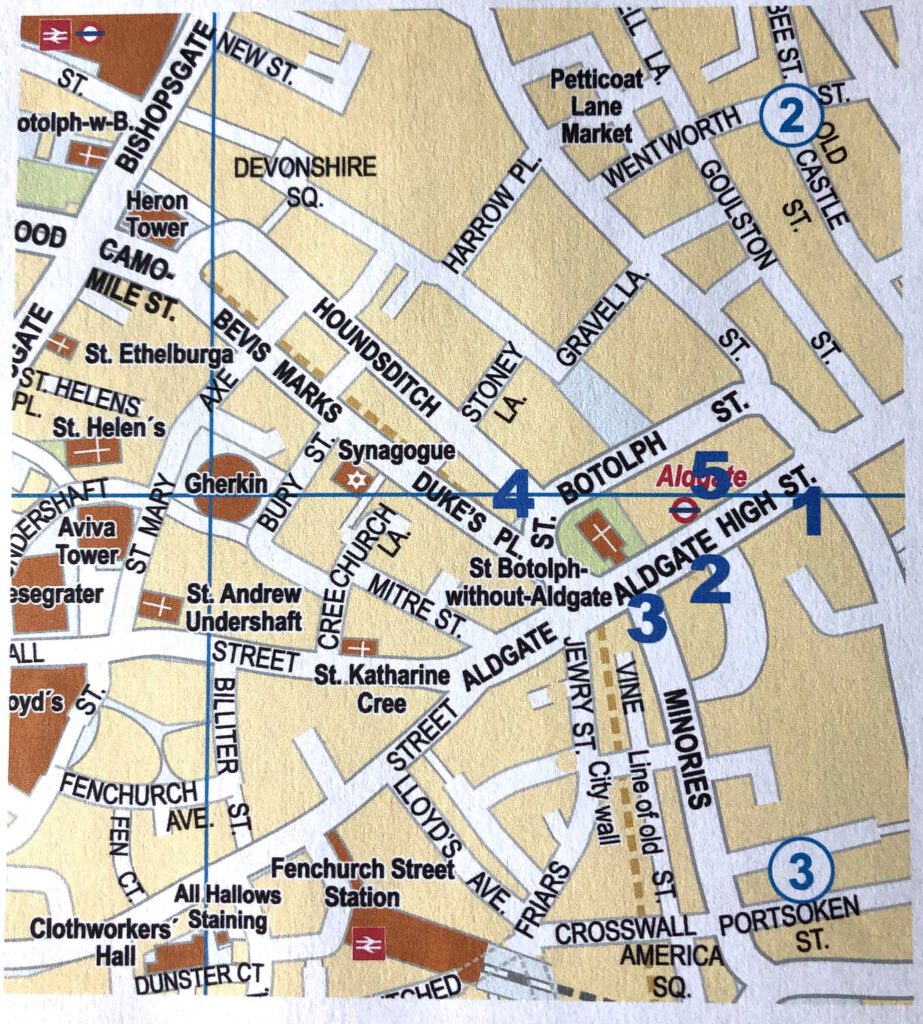The first edition of Blue Guide London was published in 1918, the year of the Spanish Flu. Work on the 19th edition was supposed to be completed in 2020, the year of Covid-19. But the measures introduced to contain the spread of the virus have brought research to a temporary halt. Curiously, the last place we revisited before lockdown was Aldgate, the parish where “H.F.”, the narrator of Daniel Defoe’s Journal of the Plague Year, was a resident. Though a fictional account, Defoe’s Journal is based heavily on fact, as supplied by observation, experience and survivors’ stories. Defoe himself knew Aldgate well. He was married in its church, which features more than once in the Journal. He describes the great plague pit that was dug in its churchyard—“a terrible pit it was”—and he also recounts an incident in the church itself:
Once, on a public day, whether a Sabbath-day or not I do not remember, in Aldgate Church, in a pew full of people, on a sudden one fancied she smelt an ill smell. Immediately she fancies the plague was in the pew, whispers her notion or suspicion to the next, then rises and goes out of the pew. It immediately took with the next, and so to them all; and every one of them, and of the two or three adjoining pews, got up and went out of the church.
Blue Guide London’s description of Aldgate reads as follows:
Busy Houndsditch, dominated by the catenary curve of the ‘Can of Ham’ Tower (Foggo Associates, 2019), follows the course of the old moat outside London’s city wall. At the the south end of it is the bright blue St Botolph Building (Grimshaw Architects, 2011), in whose glossy panels is reflected the now diminished-in-stature spire of the church of St Botolph-without-Aldgate, which stands on Aldgate Square. The square marks the site of the Aldgate, or ‘old gate’, which guarded the road out of London to the east. A ‘draught on Aldgate Pump’ (which still stands at the junction of Fenchurch St and Leadenhall St) was once a cant expression for a worthless bill. Geoffrey Chaucer leased the house above the Aldgate from the City of London in 1374. Overlooking Aldgate Square to the west is a handsome Primary School, founded in 1710 by the charitable alderman Sir John Cass (d. 1718). On the annual Founder’s Day (20th Feb), children and guests wear a red feather in honour of Cass, who suffered a fatal haemorrhage whilst writing the will by which he funded the school, staining his white goose quill red with blood. The Founder’s Day parade includes a sermon in St Botolph’s.
The church has a long history. The first chapel or oratory was built here over 1,000 years ago, outside the old City gate so that travellers could pray on arrival and departure (Botolph is the patron saint of wayfarers; relics of his were kept at churches dedicated to him at each of the London city gates). The current building is by George Dance the Elder (1744) with an interior by John Francis Bentley (1888–95). In the octagonal vestibule is a memorial to Robert Dow (d. 1612), a benefactor, with anxious-looking portrait bust, his arms clamped upon a complacently grinning skull. Daniel Defoe was married here in 1683. Thomas Bray, founder of the SPCK and SPG, was vicar here from 1708–22. Jeremy Bentham was christened here in 1747. William Symington, pioneer of steam navigation who built the Charlotte Dundas, died here ‘in want’ in 1831 and is buried here (tablet on the west wall). Built into the perimeter wall of the churchyard is an old Metropolitan Drinking Fountain of 1906, with the iron cup still attached by a chain.
So far, so good. But there are other Defoe references we could add, marked on the map below.

Beyond Aldgate Square, among massive new office blocks and thundering traffic, the ancient Hoop and Grapes pub (1) on the corner of Mansell St shows the former scale of the buildings that once stood here. Its foundations go back to the 13th century: Defoe would certainly have known it, although he chooses instead to mention two other taverns in his Journal of the Plague Year. One of them, no longer extant but which stood just to the west of the Hoop and Grapes, is the Three Nuns Inn (2), close to the entrance to the street known as Minories (3) (whose name comes from those same nuns, the Franciscan Sorores Minores, or Minoresses). It was from this end of Minories, while standing in St Botolph’s churchyard, that H.F. saw torches approaching. They were lighting a dead-cart bringing bodies to the pit, and accompanying it was a man, mourning his wife and children. Defoe describes how, overcome by grief, he is taken to the Pie Tavern at the end of Houndsditch (4), where he is mocked by a group of drunk and insensitive “plague deniers”, who end up themselves being carried off by the pestilence. And the dwelling place of H.F. himself is given with some accuracy: “I lived without Aldgate, about midway between Aldgate Church and Whitechappel Bars, on the left hand or north side of the street.” Just about where Aldgate Tube Station (5) is now, in other words.






